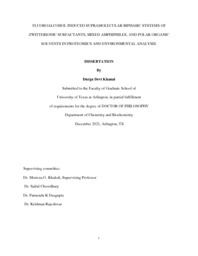| dc.description.abstract | In this research, we have investigated several HFIP-induced biphasic systems of zwitterionic surfactants like CHAPS and DMMAPS and their mixed amphiphilic systems for the extraction, enrichment, and fractionation of mixture of standard proteins and complex sample mixture of yeast proteins. The biphasic systems of zwitterionic surfactants (CHAPS and DMMAPS) and their mixed amphiphiles with quaternary ammonium salts (QUATS= TBAB, TEAB) provide concomitant extraction of hydrophobic membrane proteins, enrichment of lower abundance proteins to one phase, and fractionation of complex sample mixture into two phases. The results obtained from these biphasic systems were compared with control systems of aqueous solutions of different popular protein solubilizing reagents such as surfactants, amphiphiles, and urea. Among the different controls, 8M urea solution performed best for the total extraction of yeast proteins therefore, it was accepted the main control system throughout this project. Interestingly, the results obtained from biphasic systems of different zwitterionic surfactants and mixed amphiphiles show a significant improvement in extraction of yeast proteins from 11.5% to 18.1% greater as compared to control for the whole proteome. Addition of TBAB to both CHAPS and DMMAPS showed the highest identification improvement of 16.1% and 18.1% respectively. The FAiC-BPS of DMMAPS and mixed amphiphiles outperformed the CHAPS biphasic systems for the solubilization of hydrophobic membrane proteins and alpha helical parts of the membrane proteins with total identification improvement of 18.8% for overall membrane proteins and 26.4% and 555% for the integral component of membrane and proteins with alpha helices respectively as compared to control. The FAiC-BPS of CHAPS and mixed amphiphiles show similar or no identification improvement for the proteins with alpha helices on them.
The improvements in coverage of lower abundance proteins were considerably higher than those for the whole proteome due to significant enrichment effects of the FAiC-BP systems that enabled detection of low abundance proteins that are often undetected in conventional systems. All biphasic systems of CHAPS and DMMAPS and their mixed amphiphiles showed significant identification improvements for the lower abundance proteins below abundance 5000 molecules/cells with respect to the control. We have reported more than 100% identification improvement for low abundance proteins with an abundance range of 0-2000 molecules/cells using HFIP induced biphasic systems of DMMAPS and DMMAPS+QUATS and the best results were obtained from the system containing mixed QUATS and DMMAPS. However, identification improvement of CHAPS and the mixed amphiphilic system is slightly lower than DMMAPS systems but still shows the identification improvement of 60 to 80% higher than control. Most interestingly, in both cases, detection of low abundance proteins (Abd=0-2000 molecules/cells) is higher in mixed amphiphilic systems of CHAPS and DMMAPS. This indicates that the addition of TBAB and TEAB to CHAPS and DMMAPS improves the solubilization and enrichment capability of the system for lower abundance proteins.
Additionally, in this research, we have investigated the fractionation of protein mixtures using biphasic systems. Hydrophobic and long-chain surfactants like CHAPS and DMMAPS mostly intend to exert the hydrophobic interaction between the coacervate phase and protein molecule, therefore most of the proteins are extracted into the coacervate phase of each system. However, addition of positively charged quaternary ammonium salts (QUATS) with short chains to the zwitterionic surfactant solutions introduce electrostatic interaction to the system. Quaternary ammonium salts are mostly extracted into the coacervate phase of CHAPS and DMMAPS systems and provide positively charged sites of interaction with proteins in the coacervate phase. In HFIP induced supramolecular biphasic systems hydrophilic interaction, hydrophobic interaction, and electrostatic interaction influence protein distribution. As the result, we have observed the fractionation of protein mixture based on their isoelectric point value. In this research, we have investigated fractionation of a standard protein mixture as well as complex sample mixture of yeast proteome. In zwitterionic + QUATS systems more negatively charged acidic proteins are extracted into the coacervate phase and positively charged basic proteins are repelled into the aqueous phase.
In the second part of our research, we have investigated Associated Organic Solvents Biphasic (AOSB) for the extraction and enrichment of environmental pollutants like polycyclic aromatic hydrocarbons (PAHs), pesticides, and sex steroid hormones. We have reported the four AOSB systems with acetonitrile, acetone, n-propanol, and tetrahydrofuran as polar organic solvents and observed their phase transition behavior with HFIP and water. The compositional analysis using the GC-MS instrument report that almost 85% of total organic solvents (HFIP + second polar organic solvent) is present in bottom organic phase at their equimolar volume combination. However, the top organic phase contains around 10% of organic solvents of total volume, and around 90% of water. Due to the presence of high concentration of organic solvents in bottom phase is useful for higher solubilization and enrichment of hydrophobic small molecules. This indicates that the top phase is hydrophilic in nature and the bottom phase is hydrophobic in nature with strong that can solubilize and enrich hydrophobic small molecules. We have selected the composition of 7.5% of polar organic solvents (ACN, acetone, n-propanol, and/ THF) with 7.5% of HFIP in 85% of water as our preliminary systems. These systems have same initial compositions but gave different bottom organic phase volume. We have reported the enrichment factors of 25 to 41 for the PAHs sample in a 30 µL of bottom organic phase volume generated by 7.5% ACN+ 4 % HFIP+88.5% water and 7.5% acetone+ 3.5% HFIP+ 89% water. Similar, results were observed for the organic pesticide samples. However, some of the sex steroid hormones had smaller partition coefficients into the bottom organic phase, that resulted in lower enrichment fact. | |


